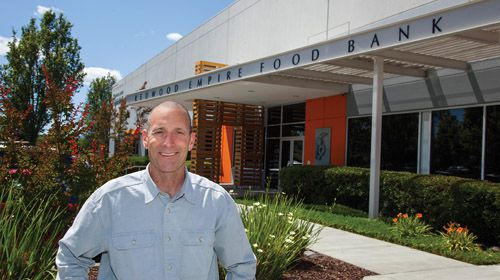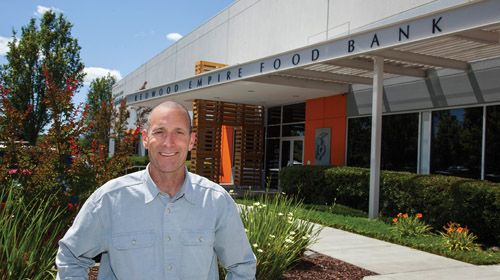
While communities rely on food drives to feed the hungry during the winter, hunger does not end after the holidays. Unfortunately, local food banks must secure enough donations during the outpouring of holiday generosity to last year-round.
When ongoing social ills or large-scale disasters prove too much for modern, trimmed-down and financially strapped government agencies, the nonprofit sector stands ready to fill the void. To that end, area food banks help provide food relief to poor and working class families, seniors, children and individuals, from the San Francisco Bay to the Oregon border.
A pair of nonprofits—the SF-Marin Food Bank and Community Action of the Napa Valley (CANV)—provide regional support to the east and south of the population centers of Sonoma County as part of a triumvirate of organizations dedicated to ending hunger at a time of skyrocketing living expenses in one of the most expensive areas in the U.S.
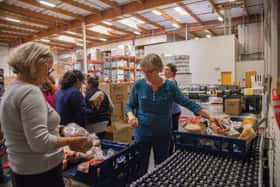 The local organization is the Redwood Empire Food Bank (REFB), delivering food to a wide swath from Annapolis to Windsor, and into the remote regions of Lake, Mendocino, Humboldt and Del Norte counties.
The local organization is the Redwood Empire Food Bank (REFB), delivering food to a wide swath from Annapolis to Windsor, and into the remote regions of Lake, Mendocino, Humboldt and Del Norte counties.
“We are the largest food bank and largest hunger relief organization from Sonoma County to the Oregon border,” says REFB Chief Executive Officer David Goodman. “Here in Sonoma County, about one in seven people receive our food. Hunger doesn’t know what month it is—whether it’s mid-summer, Thanksgiving or December. The issue requires a consistent response. If we let up or take a break during the summer, people go hungry.”
Pressing need
The Sonoma County Hunger Index Collaborative, a group of nonprofit, faith-based and government agencies, estimates food-challenged Sonoma County residents required 176 million meals in 2017. Those at risk missed 26 million meals because they couldn’t afford enough groceries. In all, 61,000 households are affected by hunger. Food assistance programs help ease that hardship by providing 45 million meals to those in need.
The number of missed meals is determined by the total number of meals low-income families need, based on USDA guidelines, subtracting the number of meals families purchase on their own and adding the number of meals provided by food assistance programs.
This “missed meal gap” is offset by a combination of government programs, many of which are means tested, such as CalFresh, formerly Food Stamps (32.7 percent), and Women, Infants and Children (WIC), which provides food to women who are pregnant, postpartum or breastfeeding, infants (up to the first birthday) and children (up to the fifth birthday).
All government programs have stringent guidelines and screening, requiring proof of income that is generally less than 200 percent of the poverty line, $24,600 per year for a family of four.
Food distribution on a massive scale
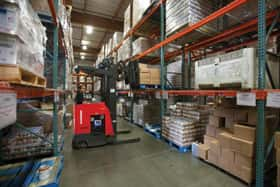 Who feeds the people that fall through the cracks and into the void of hunger?
Who feeds the people that fall through the cracks and into the void of hunger?
REFB, SFMFB and CANV are part of Bay Area Food Banks, a network of seven nonprofit entities turning donations into food in northern California. In all, the network serves about 840,000 Bay Area residents monthly, through “1,575 food pantries, children’s programs, shelters, soup kitchens, residential programs and other emergency food providers,” says Goodman. That totals about 170.8 million pounds of food each year.
They also facilitate government programs such as children’s after school programs and commodities distribution and help a challenged population navigate the bureaucratic application process for CalFresh.
“Government is approximately 12 percent of our funding,” REFB’s Goodman says. “Sometimes people think it’s a free ride, but with government funding we have to typically raise about two-thirds of the amount it takes to operate our program.”
With a yearly budget in the $8.8 million range, REFB is able to leverage more than $40 million worth of food annually and distribute it 320 miles north to hungry people in some of the most remote regions of the state through 12 programs and food pantries in communities dotting the map.
The backbone of the organization, though, is donation and volunteerism. Goodman says that if not for its 8,000 volunteers enhancing a staff of about 54, there is no way REFB could do what it does. Last year, those 8,000 volunteers gave more than 90,000 hours of their time, which is the equivalent of 43 full-time staff members. “If we had to hire 8,000 people our costs would go up pretty significantly,” he says. “We would basically have to double our staff.”
With the help of those volunteers, REFB dedicates 95 percent of its budget to food distribution with a modest 2.2 percent in administrative costs.
Through seven pantries—located in Pope Valley, Angwin, Calistoga, St Helena, Napa, Lake Berryessa and American Canyon—CANV distributes a monthly allotment of staples such as milk, eggs, cheese, meat, fresh produce and various non-perishables. There is also a Senior Brown Bag Program distributed twice per month, and the Friday Free Market Program. “We don’t use bags anymore: we live in Napa County, so we use wine boxes,” says CANV Director Shirley King. “They hold so much more.”
And like the rest of the region, the population of people age 60 and over in Napa County is exploding. CANV serves 254 senior households, up 2 percent from the previous year.
Additionally, CANV Food Bank contracts with the California State Emergency Food Assistance Program to distribute USDA Commodities. “It’s not the big, huge bricks of butter and cheese anymore,” King says. “People still continually ask for that, but they don’t use or package the same product anymore. Typically it’s non-perishable items.”
In California, each county receives a portion of the foods distributed through that program. While a percentage of the food is defined by the federal government, another portion is a result of agricultural subsidies.
“As an example,” Goodman says, “if the bottom falls out of the cranberry market and the federal government decides to buoy the cranberry market, suddenly food banks around the country are receiving cranberry cocktail, cranberry jelly, whatever they can figure out what to do with it. I don’t know about you but I usually only eat cranberry about once a year in November.”
Hunger in the Wine Country
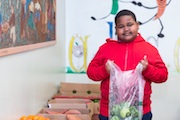 Community action agencies owe their existence to President Lyndon Johnson’s “War on Poverty.” In 1964, Johnson signed into law the Economic Opportunity Act to “eliminate the paradox of poverty in the midst of plenty in this nation by opening to everyone the opportunity—to live in decency and dignity.”
Community action agencies owe their existence to President Lyndon Johnson’s “War on Poverty.” In 1964, Johnson signed into law the Economic Opportunity Act to “eliminate the paradox of poverty in the midst of plenty in this nation by opening to everyone the opportunity—to live in decency and dignity.”
CANV Food Bank faces issues on a daily basis that stem from the remoteness of places like Angwin and Pope Valley, but also from the perception of wealth in a premier wine region that attracts wealthy visitors from around the globe.
King says one in eight individuals in Napa County is food insecure. “The highest percentages of people we serve right now are working class poor. Most people we serve are working more than one job. There’s just not a lot of people that can afford to live here.”
Although there was recently a three-year reduction in the number of clients CANV serves, a survey conducted by the nonprofit finds it is the result of working-class poor taking flight to more affordable areas, whereas in the past they move on to Lake County or Vallejo to continue working locally. Now, they’re moving further away to places like Lodi or Clovis, where they can get a job and still afford to live.
“The cost of living is so high, that it’s definitely made a huge impact,” King says.
Likewise in Marin County, which is not technically the Wine Country, but suffers the same demographic challenges of its neighbors to the north.
“Many of the people that use our various food pantries and programs are working people with one or two adults working in the house, some even working multiple jobs, many with kids who just can’t make it all add up,” says Becky Gershon, policy and advocacy manager for the San Francisco-Marin Food Bank (SFMFB). As to federal poverty levels, “We use 200 percent of the federal poverty level as a proxy for being at risk for food insecurity,” she says. “That’s $41,560 for a family of three—which is nearly impossible to live on in the Bay Area.”
The overarching philosophy of all food pantries though, is that anyone who needs food gets food. Or, as King puts it, “Most people aren’t going to go wait in line for food if they don’t really need it. We don’t find ourselves to be a policing agent or enforcer of whether or not you meet the criteria based on your income. If you need food, it’s our job to give it away.”
Community action
By far, the majority of nonprofit food distribution organizations’ budgets are philanthropic in nature and donations represent 85 to 90 percent of the budget. For every dollar brought into a food bank, anywhere from $5-$8 in food goes out.
An organization like CANV acts as an access point for 42 nonprofits and religious organizations that serve farm workers, shelters, women facing difficulties, and soup kitchens such as the Salvation Army. The food is offered for free in a lot of cases or for $.19 a pound for purchase. CANV can do that because King is able to parlay monetary donations into inexpensive foodstuffs. For instance, she is able to get apples for $.06 or $.08 a pound and sweet potatoes or cauliflower for $.29 per pound to augment food donations.
But efficiently distributing food is a costly endeavor, particularly when it has to travel a long way to places that aren’t easy to access. It takes trucks and manpower, and the costs of registration and maintenance of the vehicles, let alone the operational funding needed to pay for staffing, can be exorbitant. And getting food from Napa to Pope Valley, for instance, takes an inordinate amount of time. Government funding is either targeted for specific programs, or, when operational funding is attached, it’s usually inadequate.
Like all the other food banks, CANV is heavily dependent on volunteers to sort, package and load trucks destined for hungry mouths in the far reaches of its sphere of influence.
“You can imagine the nutrient-dense food we could distribute if we didn’t stress out over the funds,” says King. “If we got money we could leverage the funds much better than the average person going to Costco or something.”
As to fundraising, the majority takes place around the holidays. Schools and businesses have food drives; there are “Turkey Trot” fundraisers and giving is at the forefront of most people’s minds.
“We’re grateful that there’s a tremendous outpouring of generosity in October, November and December because we live off that generosity for months to come. That’s true of every hunger relief organization in the country,” says King. But, “Hunger doesn’t know whether it’s Thanksgiving or the day after Thanksgiving. It doesn’t really care.”
Partnering with businesses and corporations
For the rest of the year, food banks often rely on the volunteerism and giving that is part of institutional culture.
“We have lots of partnerships with all types of businesses in San Francisco and Marin,” says Gershon. “We have businesses that (support us) in the form of finances; we have businesses that come in to volunteer once a month; we have businesses that hold holiday food drives once a year. Our hope would be that enthusiasm during the holidays carries throughout the year as well, which sometimes can be a little hard.”
According to Mark Seelig, public relations manager of San Francisco-Marin Food Bank, volunteers and donors come from all walks of life. From residents who just want to help strengthen their community, to a local video game production company, to Grateful Dead bassist Phil Lesh.
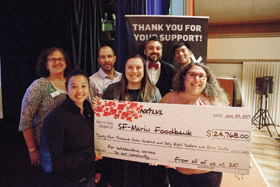 2K Games, based in Novato, regularly provides a dozen volunteers every year to repackage food in our warehouse. The company also hosted a special trivia night fundraiser, that some say may become an annual event.
2K Games, based in Novato, regularly provides a dozen volunteers every year to repackage food in our warehouse. The company also hosted a special trivia night fundraiser, that some say may become an annual event.
“It was a fun night getting together and fundraising with all these folks from the gaming world,” Seelig says. “There was fabulous food and drinks, unbelievable prizes, and a lot of smiles in that room. And at the end of the night, they surprised us with a check for $25,000. It was amazing.”
According to 2K Vice President of human resources, Gail Hamrick, the employees of the organization are community-minded citizens, which makes it easy for them to implement the 2K Next Level Program to provide company-sponsored opportunities to support our community and the people in it.
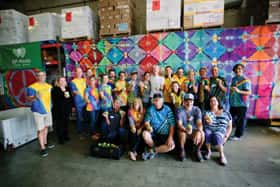 “I think everyone shares in the belief that no one should ever go hungry and no one understands the importance of that more than the SF-Marin Food Bank,” she says. “Every day, the food bank is doing its part to help those in need and I’d encourage anyone looking to make a difference in their community to reach out to them.”
“I think everyone shares in the belief that no one should ever go hungry and no one understands the importance of that more than the SF-Marin Food Bank,” she says. “Every day, the food bank is doing its part to help those in need and I’d encourage anyone looking to make a difference in their community to reach out to them.”
Last year, Lesh volunteered at the warehouse in Novato, offering anyone who donated $500 a chance to work with him in the warehouse. Afterwards, he held a fundraiser at his Terrapin Crossroads venue, raising $15,000.
A passion for feeding people
Despite what may be the perception, food banks are not government-funded organizations and most of what they do is through the private sector. This makes the organizations “nimble, responsive, innovative and correctable,” according to Goodman. Leadership of the organizations are dedicated to the mission of feeding people, in an atmosphere that can seem thankless. “Literally, you’re not doing it for the money,” says King. “You’re passionate about what you do.”
The people served by food banks are “just regular people who for one reason or another, through decisions they’ve made in their lives or circumstances beyond their control, find themselves in need of help. And hunger can’t be the price they pay,” says Goodman.
He illustrates the dynamics by comparing food banks to 911 “for people that need food.”
“When you’re running out of air and you can’t breathe, you dial 911,” he says. “The paramedics come to your home and they help you; they revive you; they take you to the hospital and they get you back on your feet. But if you run out of food that’s essential to survival and you call 911—try it sometime: Call 911 and say you’ve run out of food. I have some bad news: Nobody’s coming.”
What’s Considered Poverty Level?
The Department of Health and Human Services issues an annual report to measure income and determine the federal poverty levels (FPL). These numbers determine eligibility for programs, benefits and health coverage. Here are the 2018 federal poverty level income numbers:
Individuals: $12,140
Family of 2: $16,460
Family of 3: $20,780
Family of 4: $25,100
Family of 5: $29,420
Family of 6: $33,740
Family of 7: $38,060
Family of 8: $42,380
Join In!
Take a bite out of hunger, and get involved. There are two key ways you can help. Volunteer with local agencies that help hungry families. Or, donate food and money. For information, go to SonomaHungerIndex.com. Here’s a list of local nonprofits that will welcome your help:
Redwood Empire Food Bank, located at 3990 Brickway Blvd., Santa Rosa, Calif. 95403, (707) 523-7900, info@refb.org, refb.org
Community Action of Napa Valley, located at 2310 Laurel St. #1, Napa, Calif. 94559, (707) 253-6100, canv@can-v.org, canv.org
SF-Marin Food Bank, located at 900 Pennsylvania Ave., San Francisco, Calif. 94107, (415) 282-1900, Marin, 75 Digital Dr., Novato, Calif. 94949, (415) 883-1302, info@sfmfoodbank.org, www.sfmfoodbank.org
Bay Area Food Banks, (800) 870-3663, info@bayareahunger.org, www.bayareahunger.org
Firestorm 2017: Community Response
The tragic fires that wiped out entire communities in Sonoma and Napa counties last October left many residents from all socio-economic strata lost and homeless, many without the means to fill their larders for those fortunate enough to still have larders. A massive community effort allowed the Redwood Empire Food Bank (REFB) to gather and distribute 1 million pounds of food donated in the span of two weeks.
“About 400,000 pounds of (food donations) was people walking up,” says David Goodman, chief executive officer. “That’s a staggering amount, and it does speak to Sonoma County. I’m sure people step up everywhere and we see it on the news. I can’t speak on all points, but I know the response from the people of Sonoma County has been remarkable.”
Community Action Network of Napa Valley (CANV) had challenges of its own, with the lack of power, cell phone and Internet. Napa County was on the receiving end of the firestorm with the Tubbs, Nuns and Atlas fires all affecting the area. In the week following the onslaught, while fires were still raging through the countryside, CANV provided 1,646 emergency food allotments to people suddenly in need and helped other nonprofits provide food at emergency evacuation sites.
“It was a huge, huge, overwhelming and gracious response,” says Shirley King, director, CANV. “People were driving in from all over—Sacramento, Milpitas—donating food and non-food items.”
In the event of a disaster on the scale of the October fires, food banks are part of disaster plans and food collection and distribution becomes a recovery effort by multiple organizations. “The Bay Area Food Banks has an agreement that when one of the food banks is in distress through a disaster, the other area food banks will assist in the efforts,” says Becky Gershon, senior policy advisor for the SF-Marin Food Bank.
Not only did the SFMFB step up with trucks and staffing to help manage and distribute the impressive influx of food, the nonprofit also sent representatives to the affected areas to help those in need apply for emergency portions through Disaster CalFresh, a state program of the California Department of Social Services. The effort was made even more difficult, as there was a seven-day window for application and most people directly affected by the fires were staying with friends and family members rather than congregating at shelters and community centers.
While many people had the financial wherewithal to find food and shelter, many more did not have the means or ability to navigate a complex system for recovery.
“The people that worked for those folks are the ones that were most impacted,” King says. “They’re living paycheck to paycheck and suddenly their employer is not there anymore because their house burned down. We have lots of housekeepers, landscapers, cooks, pool service people who just lost their livelihood.”
The outpouring of support and food speaks to the resiliency and community spirit of the region, but hunger is a year-round problem that exists even when there is not an historic catastrophe at hand.
“I’m pleased and gratified that the immediate response was generous and swift,” says Goodman, “but where the ultimate test is going to be is whether that type of generosity continues over the long haul. We all know people who have been touched by it and see ourselves reflected in that experience. … Nobody ever expects to be in a food line.”


